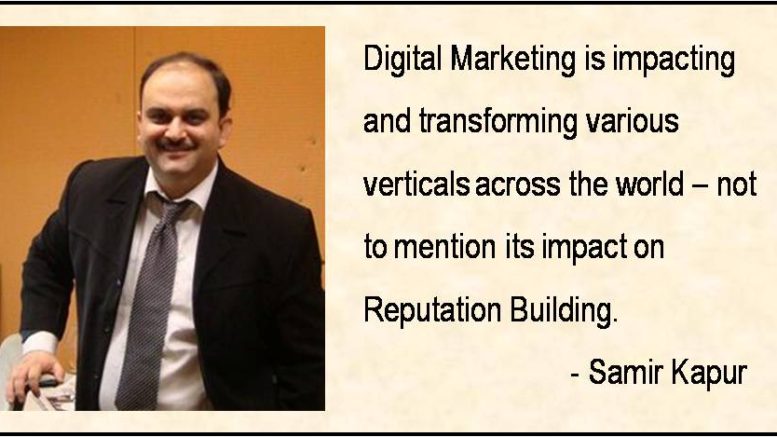With the digital universe growing at a scorching pace, many domains – from publishing, marketing and advertising to public relations, among others – are experiencing the impact of the consequent changes in brand perception. Professionals in numerous domains are therefore confronted with novel challenges and unexpected opportunities, even as they come to grips with the changing dynamics of the digital era.
Despite the initial scepticism of many professionals, the digital world has made serious inroads into the everyday lives of consumers globally. Every year, empirical evidence indicates, that consumers are spending more time online, perusing different digital platforms.
Advantages of Digital Deals
Over the past few years, the smart phone revolution has captured the minds of customers, especially the younger generation, who are now engaged online almost 24×7. Be it bookings, purchases, reviews or what-have-you, today’s generation is willing to log on instantly and use the digital medium to get things done, rather than step out into the open and expend extra energy on doing the same things. Whether it is Google, Twitter, Facebook, LinkedIn, YouTube, Blogs and other digital channels, the virtual universe is giving a run for its money to the real world.
Given the ever-rising online ‘ground’ reality, the best of brands have progressively begun to take serious note of the digital medium. Advertising, publishing and public relations professionals are gradually taking cognizance of this phenomenon and moving larger amounts of their budgets to the new medium.
Against this backdrop, public relations professionals have little choice but to quickly understand the dynamics of the online universe and reputation building in the digital era. Reputation building in the digital era has been gaining rising traction as companies find they can reach their target audience at much lower spends compared to conventional marketing mediums. What’s more, digital tools can evaluate the efficacy of specific marketing campaigns. Thereby, digital marketers can decide how to optimise marketing spends more effectively. None of these advantages exist in traditional marketing.
As clients impose cost-cutting measures in an increasingly competitive environment, PR practitioners have realised that they too can secure more bang for the buck through digital marketing means. These include Search Engine Marketing, Social Media Marketing, Search Engine Optimisation and Social Media Analytics, among others. But for brands and consultancies to truly capitalise on the digital medium, it’s imperative they first comprehend the complexities of the digital universe and the perils of using the medium without a thorough understanding. Proper understanding can ensure they strategise well and offer full value to their clients via digital marketing.
For lay readers, it’s important to know that today’s Worldwide Web is termed Web 2.0, with the earlier avatar being Web 1.0. While the latter was a read-only version, Web 2.0 is immensely popular as a read-write world. Significantly, the Web 2.0 revolution has been enabling the four C’s: collaboration; community creation; conversation; creativity.
Although digital marketing primarily denotes Internet-based marketing, it can include non-Internet avenues such as cell phones (SMS and MMS), call-back, on-hold mobile ring tones, display advertising, social media marketing, e-books, e-games and other forms of digital media. Among the plethora of options, the importance of mobile phones cannot be underestimated. Today, mobile searches, mobile conversations and mobile optimisation are one of the primary avenues through which customers procure information about products they wish to purchase. It wouldn’t be amiss to state that modern consumers (and the masses) are addicted to mobile phones. Therefore, digital marketers and PR practitioners need to accord pride of place to mobile marketing strategies in their scheme of things.
Social Dominates Media
When using the term ‘social media’, many analysts make the mistake of treating ‘media’ as the operative word, whereas it is ‘social’ that qualifies for that distinction. It’s the social aspect that encourages and enables people to share and interact freely with one another; in such a milieu, content has come to acquire a life and importance all its own. Additionally, content has truly become king by being less controlled as well as more democratic and public-oriented in nature. With the ability to connect 24×7, customers are no longer averse to sharing their unbridled opinions and feelings about various products and services.
The credit for these fundamental changes in consumer behaviour and their direct interactions with brands goes largely to Web 2.0. Conversely, while consumers are more democratic but brash, companies need to be more circumspect about how they manage online relationships and behaviour with various stakeholders, including empowered consumers. Web 2.0 having triggered new behaviour patterns from consumers, brands and marketers need to devise new strategies and more targeted messages that can work their magic much faster, although their effectiveness may not necessarily be as longstanding as in the days prior to online marketing.
With the changing scenario in customer behaviour globally, companies have come under increasing pressure to devise new ways and means to keep pace with their varying trends and expectations. In turn, clients have raised the bar with PR consultancies, expecting them to offer digital marketing strategies as part of mainstream deliverables and at no extra cost. The heightened expectations from clients have had most PR firms scrambling to get their act together and devising a coherent digital marketing strategy.
In embracing the digital universe, PR strategists should note the divergence in consumer behaviour in the social media era, compared to the pre-Internet years. Unlike customers of earlier generations, today’s social media fans are most willing to listen to and trust the advice of online acquaintances and perfect strangers, who blog or voice their opinions on online forums. They also shop online, rather than offline, more often and are eager to provide feedback about the product or service.
Furthermore, marketing in the pre-Internet era was primarily one-dimensional, with the message merely being delivered. Digital marketing is two-dimensional, with social media marketers beginning conversations and building relationships with clients. In this two-way process, brands engage with their target audiences regularly. This not only helps in disseminating messages, but in understanding customers’ perceptions and preferences. Assimilation of this data on a mass scale helps brands better their offerings and keep abreast of changing customer tastes.
Content and other Kings
Another significant change Web 2.0 has brought about is giving content creators more opportunities to display their skills. Moreover, with the advent of blogs and later vlogs (video logs) customers have more avenues to voice their likes and dislikes, much to the chagrin of brands at the receiving end.
With social media’s ability to trigger a crisis almost overnight, the need for good content creators has become more critical. Although finding great content writers has been a perennial problem, simply possessing good writing skills cannot save the day where digital marketing is concerned. To address this medium effectively, content creators need to possess robust domain knowledge, especially experiential knowledge, which denotes the difference between saving the day and ending up at the cleaners. If good content writers comprise part of the team, one-quarter (if not half!) of the battle can be considered won.
Besides content, another ‘C’ needs to be closely watched: CRO or conversion rate optimisation. CRO connotes the process of maximising the number of site visitors who are converted or end up making a purchase. To achieve higher conversions, it is critical to thoroughly comprehend users and split-test changes on a portal. Thereby, digital marketers can better understand what type of a website or landing page could result in better number of conversions. While this seems a cumbersome process, it pays off in the end via higher sales.
The other factor that should be considered seriously is segmentation. For successful digital marketing, it’s important to target select markets, both in business-to-business and business-to-consumer segments.
Then there’s influencer marketing – another key concept in digital targeting, wherein crucial nodes are identified within related communities, referred to as influencers. These influencers could be reached through paid advertising, which would include Facebook Advertising, or via complex sCRM (social customer relationship management) software. In this case, it makes sense to devise select engagement strategies for influencers.
Considering the increasingly competitive ambience in the global digital marketplace, PR strategists and their digital marketing professional would need to use pull as well as push digital marketing. The former refers to digital marketing where consumers actively seek marketing content, while the latter denotes marketers sending communiqués without this content being specifically sought by the recipients. It should be noted that push and pull marketing can be used in tandem, if required.
Reading the above, astute readers may have realised that this write-up hasn’t even dealt in detail with Twitter, Blogs and YouTube videos. That’s not to say they aren’t crucial cogs in the wheels of digital marketing. But since these already occupy the popular mind space, one takes it for granted digital marketers will be savvy enough to include them in their arsenal.
Finally, if smart readers have mastered some of the above strategies, it would still not make sense to put their feet up or let their hair down. Since digital technologies are constantly evolving, and rapidly too, one can never rest on past laurels. Instead, constantly keep reviewing marketing strategies. Failure to respect this tenet may end up turning the best of digital marketers into also-rans as technological changes swiftly swamp the digital landscape.
As they say, ‘forewarned is forearmed’ – and it’s no different in the world of digital marketing.



Be the first to comment on "Reputation building in the Digital Era"